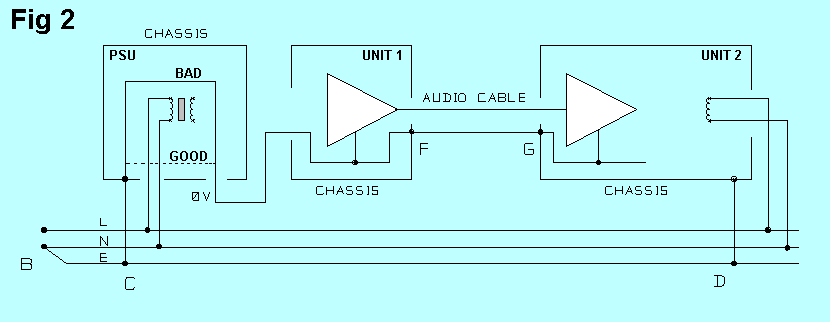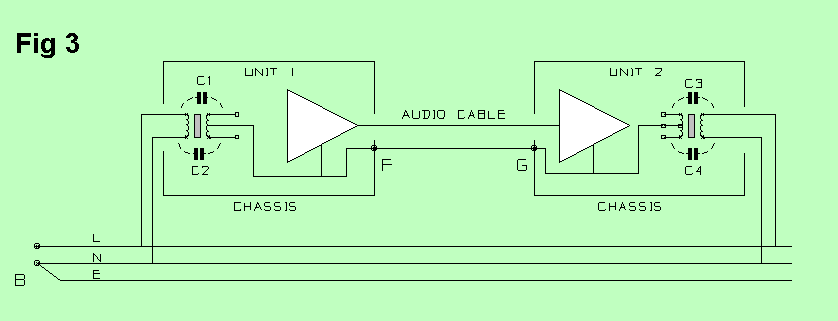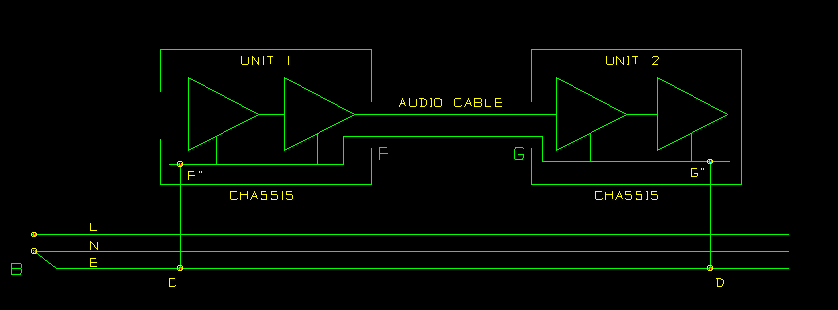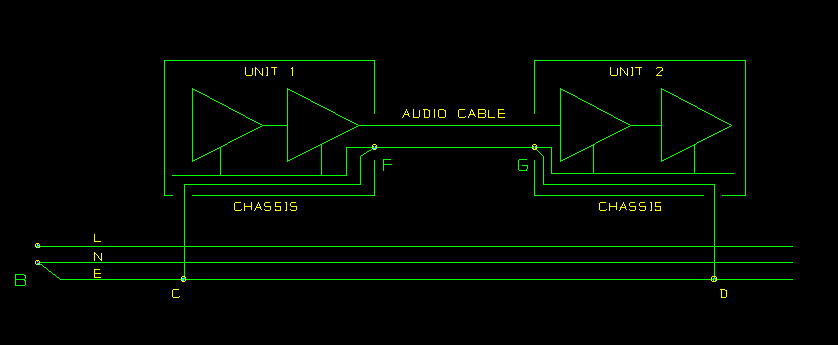Updated: 9 Oct 2001




Ground Loops. |
Updated: 9 Oct 2001 |
A ground-loop is created whenever two or more pieces of mains-powered equipment are connected together, so that mains-derived AC flows through shields and ground conductors, degrading the noise floor of the system. The effect is worst when two or more units are connected through mains ground as well as audio cabling, and this situation is what is normally meant by the term "ground-loop". However, ground currents can also flow in systems that are not galvanically grounded; they are of lower magnitude but can still degrade the noise floor, so this scenario is also considered here.
The ground currents may either be inherent in the mains supply wiring (see "1: Mains grounding currents") or generated by one or more of the pieces of equipment that make up the audio system.(see "2: Transformer stray magnetic fields" and "3: Transformer stray capacitance")
Once flowing in the ground wiring, these currents will give rise to voltage-drops that introduce hum and buzzing noises. This may occur either in the audio interconnects, or inside the equipment itself if it is not well-designed. See Section 4.
Here I have used the word "ground" for conductors and so on, while "earth" is reserved for the damp crumbly stuff into which copper rods are thrust.
HUM INJECTION BY MAINS GROUNDING CURRENTS.
Two pieces of audio equipment are connected to this mains wiring at C and D, and joined to each other through an unbalanced cable F-G. Then an ill-advised connection is made to earth at D; the 1V rms is now impressed on the path B-C-D, and substantial current is likely to flow through it, depending on the total resistance of this path. There will be a voltage-drop from C to D, its magnitude depending on what fraction of the total BCDE resistance is made up by the section C-D. The earth wire C-D will be of at least 1.5 sqmm cross-section, and so the extra connection FG down the audio cable is unlikely to reduce the intefering voltage much.
The best way to solve this problem is not to create it in the first place. If some ground current is unavoidable then the use of balanced inputs (or ground-cancel outputs- it is not necessary to use both) should give at least 40 dB of rejection at audio frequencies.
Fig 1 also shows a third earthing point, which fortunately does not complicate situation. Metal water pipes are bonded to the incoming mains ground for safety reasons, and since they are usually electrically connected to an incoming water supply current flows through B-W in the same way as it does through the copper rod link D-E. This water-pipe current does not however flow through C-D and cannot cause a ground-loop problem. It may however cause the pipes to generate an AC magnetic field which is picked up by other wiring.
HUM INJECTION BY TRANSFORMER STRAY FIELDS.
Here Unit 1 has an external DC power-supply; this makes it possible to use an inexpensive frame-type transformer which will have a large stray field. But... note that the wire in the PSU which connects mains ground to the outgoing 0V takes a half-turn around the transformer, and significant current will be induced into it, which will flow round the loop C-F-G-D, and give an unwanted voltage-drop between F and G. In this case reinforcing the ground of the audio interconnection is likely to be of some help, as it directly reduces the fraction of the total loop voltage which is dropped between F and G.
HUM INJECTION BY TRANSFORMER STRAY CAPACITANCE.
Fig 3 shows two Class-II units connected together by an unbalanced audio cable. The two mains transformers in the units have stray capacitance from both live and neutral to the secondary. If these capacitances were all identical no current would flow, but in practice they are not, so 50 Hz currents are injected into the internal 0V rail and flow through the resistance of F-G, adding hum to the signal.
The magnitude of ground current varies with the details of transformer construction, and increases as the size of the transformer grows. Therefore the more power a unit draws, the larger the ground current it can sustain. This is why many systems are subjectively hum-free until the connection of a powered subwoofer, which is likely to have a larger transformer than other components of the system.
Fig 1 shows what happens when a so-called "technical ground" like a buried copper rod
is attached to a grounding system which is already connected to "mains
ground" at the power distribution board. The latter is mandatory both legally and technically, so one might as well accept this and denote as the reference ground. In many cases this "mains ground" is actually the neutral conductor, which is only grounded at the remote transformer substation. AB is the cable from substation to consumer, which serves many houses from connections tapped off along its length. There is substantial current flowing down the N+E conductor, so point B is often 1 Volts rms or more above earth. From B onwards, in the internal house wiring, neutral and ground are always separate. (In the UK, anyway)

To get a feel for the magnitudes involved, take a plausible ground current of 1 Amp. The 1.5 sqmm ground conductor will have a resistance of 0.012 Ohms/metre, so if the mains sockets at C and D are one metre apart, the voltage C-D will be 12 mV rms. Almost all of this will appear between F and G, and will be indistinguishable from wanted signal to the input stage of Unit 2, so the hum will be severe, probably only 30 dB below the nominal signal level.
Fig 2 shows a thoroughly bad piece of physical layout which will cause ground currents to flow even if the system is correctly grounded to just one point.

It is difficult to put any magnitudes to this effect because it depends on many imponderables such as the build quality of the transformer and the exact physical arrangement of the ground cable in the PSU. If this cable is rerouted to the dotted position in the diagram, the transformer is no longer enclosed in a half-turn, and the effect will be much smaller.
It seems at first sight that the adoption of Class-II (double-insulated) equipment throughout an audio system will give inherent immunity to ground-loop problems. Life is not so simple, though it has to be said that when such problems do occur they are likely to be much less severe.
This problem afflicts all Class-II equipment to a certain extent.

A balanced input or ground-cancelling output will remove or render negligible the ill-effects. Reducing the resistance of the interconnect ground path is also useful- more so than with other types of ground loop, because the ground current is essentially fixed by the small stray capacitances, and so halving the resistance F-G will dependably halve the interfering voltage. There are limits to how far you can take this- while a simple balanced input will give 40dB of rejection at low cost, increasing the cross-sectional area of copper in the ground of an audio cable by a factor of 100 times is not going to be either easy or cheap.
Fig 3 shows equipment with metal chassis connected to the 0V; (this is quite acceptable for safety approvals- what counts is the isolation between mains and everything else, not between low-voltage circuitry and touchable metalwork) note the chassis connection however has no relevance to the basic effect, which would still occur even if the equipment enclosure was completely non-conducting.
| Power consumption | Ground current
| Turntable, CD, cassette deck | 20W or less | 5 uA
| Tuners, amplifiers, small TVs | 20-100W | 100 uA
| Big amplifiers, subwoofers, large TVs | More than 100W | 1mA
| |
GROUND CURRENTS INSIDE EQUIPMENT.
Once ground currents have been set flowing, they can degrade system performance in two locations: outside the system units, by flowing in the interconnect grounds, or inside the units, by flowing through internal PCB tracks, etc. The first problem can dealt with effectively by the use of balanced inputs, but the internal effects of ground currents can be much more severe if the equipment is poorly designed.

Fig 4 shows the situation. There is, for whatever reason, ground current flowing through the ground conductor CD, causing an interfering current to flow round the loop CFGD as before. Now, however, the internal design of Unit 2 is such that the ground current flowing through FG also flows through G-G' before it encounters the ground wire going to point D. G-G' is almost certain to be a PCB track with higher resistance than any of the cabling, and so the voltage drop across it can be relatively large, and the hum performance correspondingly poor. Exactly similiar effects can occur at signal outputs; in this case the ground current is flowing through F-F'.
Balanced inputs will have no effect on this; they can cancel out the voltage-drop along F-G, but if internal hum is introduced further down the internal signal path, there is nothing they can do about it.

The correct method of handling this is shown in Fig 5. The connection to mains ground is made right where the signal grounds leave and enter the units, and are made as solidly as possible. The ground current no longer flows through the internal circuitry. It does however still flow through the interconnection at FG, so either a balanced input or a ground-cancelling output will be required to deal with this.
  
|